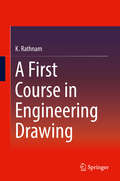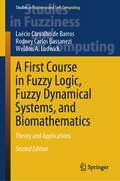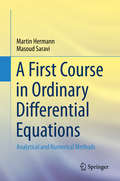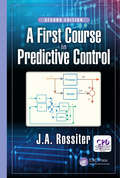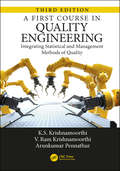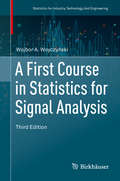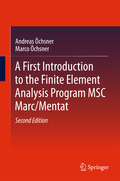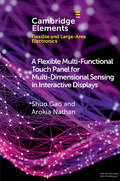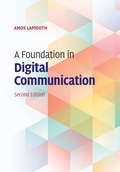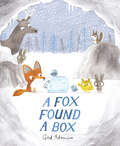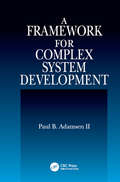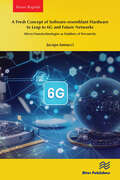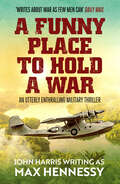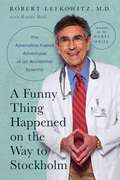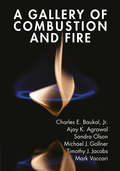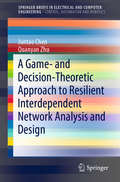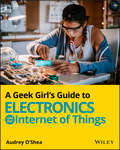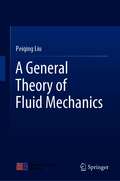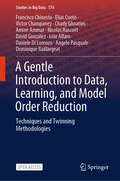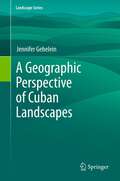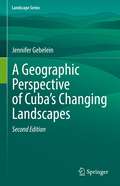- Table View
- List View
A First Course in Engineering Drawing
by K. RathnamThe primary objective of this book is to provide an easy approach to the basic principles of Engineering Drawing, which is one of the core subjects for undergraduate students in all branches of engineering. Further, it offers comprehensive coverage of topics required for a first course in this subject, based on the author's years of experience in teaching this subject. Emphasis is placed on the precise and logical presentation of the concepts and principles that are essential to understanding the subject. The methods presented help students to grasp the fundamentals more easily. In addition, the book highlights essential problem-solving strategies and features both solved examples and multiple-choice questions to test their comprehension.
A First Course in Fuzzy Logic, Fuzzy Dynamical Systems, and Biomathematics: Theory and Applications (Studies in Fuzziness and Soft Computing #432)
by Rodney Carlos Bassanezi Weldon A. Lodwick Laécio Carvalho de BarrosThis book provides an essential introduction to the field of dynamical models. Starting from classical theories such as set theory and probability, it allows readers to draw near to the fuzzy case. On one hand, the book equips readers with a fundamental understanding of the theoretical underpinnings of fuzzy sets and fuzzy dynamical systems. On the other, it presents some concepts of derivatives, integrals and differential equations applied to the context of fuzzy functions. Each of the major topics is accompanied by examples, worked-out exercises, and exercises to be completed. Moreover, many applications to real problems are presented, mainly in biomathematics where the so-called p-fuzzy systems play an important role. The book has been developed on the basis of the authors’ lectures to university students and is accordingly primarily intended as a textbook for both upper-level undergraduates and graduates in applied mathematics, statistics, and engineering. It also offers a valuable resource for practitioners such as mathematical consultants and modelers, and for researchers alike, as it may provide both groups with new ideas and inspirations for projects in the fields of fuzzy logic and biomathematics. This thoroughly updated second edition includes a new chapter on fuzzy optimization, which also presents an application in carbon markets analysis and modeling
A First Course in Ordinary Differential Equations: Analytical and Numerical Methods
by Martin Hermann Masoud SaraviThis book presents a modern introduction to analytical and numerical techniques for solving ordinary differential equations (ODEs). Contrary to the traditional format--the theorem-and-proof format--the book is focusing on analytical and numerical methods. The book supplies a variety of problems and examples, ranging from the elementary to the advanced level, to introduce and study the mathematics of ODEs. The analytical part of the book deals with solution techniques for scalar first-order and second-order linear ODEs, and systems of linear ODEs--with a special focus on the Laplace transform, operator techniques and power series solutions. In the numerical part, theoretical and practical aspects of Runge-Kutta methods for solving initial-value problems and shooting methods for linear two-point boundary-value problems are considered. The book is intended as a primary text for courses on the theory of ODEs and numerical treatment of ODEs for advanced undergraduate and early graduate students. It is assumed that the reader has a basic grasp of elementary calculus, in particular methods of integration, and of numerical analysis. Physicists, chemists, biologists, computer scientists and engineers whose work involves solving ODEs will also find the book useful as a reference work and tool for independent study. The book has been prepared within the framework of a German-Iranian research project on mathematical methods for ODEs, which was started in early 2012.
A First Course in Predictive Control, Second Edition (Control Series)
by J. A. RossiterThe book presents a significant expansion in depth and breadth of the previous edition. It includes substantially more numerical illustrations and copious supporting MATLAB code that the reader can use to replicate illustrations or build his or her own. The code is deliberately written to be as simple as possible and easy to edit. The book is an excellent starting point for any researcher to gain a solid grounding in MPC concepts and algorithms before moving into application or more advanced research topics. Sample problems for readers are embedded throughout the chapters, and in-text questions are designed for readers to demonstrate an understanding of concepts through numerical simulation.
A First Course in Quality Engineering: Integrating Statistical and Management Methods of Quality, Third Edition
by K. S. Krishnamoorthi V. Ram Krishnamoorthi Arunkumar PennathurThe third edition of this textbook improves on the strengths of the earlier editions both in content and presentation. Of the important features of the textbook is the inclusion of examples from real-world to illustrate use of quality methods in problem solving. A thorough revision is made of the text to make all chapters suitable for self-study as well.
A First Course in Statistics for Signal Analysis (Statistics for Industry, Technology, and Engineering)
by Wojbor A. WoyczyńskiThis self-contained and user-friendly textbook is designed for a first, one-semester course in statistical signal analysis for a broad audience of students in engineering and the physical sciences. The emphasis throughout is on fundamental concepts and relationships in the statistical theory of stationary random signals, which are explained in a concise, yet rigorous presentation. With abundant practice exercises and thorough explanations, A First Course in Statistics for Signal Analysis is an excellent tool for both teaching students and training laboratory scientists and engineers. Improvements in the second edition include considerably expanded sections, enhanced precision, and more illustrative figures.
A First Introduction to the Finite Element Analysis Program MSC Marc/Mentat
by Andreas Öchsner Marco ÖchsnerThis book offers a brief introduction to the general-purpose finite element program MSC Marc, focusing on providing simple examples, often single-element problems, which can easily be related to the theory that is discussed in finite element lectures. As such, it is an ideal companion book to classical introductory courses on the finite element method. MSC Marc is a specialized program for non-linear problems (implicit solver), which is distributed by the MSC Software Corporation and commonly used in academia and industry. The documentation of all finite element programs now includes a variety of step-by-step examples of differing complexity, and all software companies offer professional workshops on different topics. Since the first edition of the book, there have been several new releases of Marc/Mentat and numerous changes. This new edition incorporates the latest Marc/Mentat software developments and new examples.
A Flexible Multi-Functional Touch Panel for Multi-Dimensional Sensing in Interactive Displays (Elements in Flexible and Large-Area Electronics)
by Arokia Nathan Shuo GaoTouch screen panels (TSPs) have become an integral part of modern-day lifestyle. To enhance user experience, attributes such as form-factor flexibility, multi-dimensional sensing, low power consumption and low cost have become highly desirable. This Element addresses the design of multi-functional TSPs with integrated concurrent capture of ubiquitous capacitive touch signals and force information. It compares and contrasts interactive technologies and presents design considerations for multi-dimensional touch screens with high detection sensitivity, accuracy and resolution.
A Foundation In Digital Communication
by Amos LapidothThis intuitive yet rigorous introduction derives the core results of digital communication from first principles. Theory, rather than industry standards, motivates the engineering approaches, and key results are stated with all the required assumptions. The book emphasizes the geometric view, opening with the inner product, the matched filter for its computation, Parseval's theorem, the sampling theorem as an orthonormal expansion, the isometry between passband signals and their baseband representation, and the spectral-efficiency optimality of quadrature amplitude modulation (QAM). Subsequent chapters address noise, hypothesis testing, Gaussian stochastic processes, and the sufficiency of the matched filter outputs. Uniquely, there is a treatment of white noise without generalized functions, and of the power spectral density without artificial random jitters and random phases in the analysis of QAM. This systematic and insightful book, with over 300 exercises, is ideal for graduate courses in digital communication, and for anyone asking 'why' and not just 'how'.
A Fox Found a Box
by Ged AdamsonWhen his radio breaks, a little fox finds that the forest is filled with its own rhythm and music--drip drops and chirp chirps--in this picture book that gently introduces the concept of mindfulness.A little fox is digging for food when--OUCH! What is that?--the fox finds a box! When the fox brings the box home to his animal friends--and turns a funny-looking knob--the box starts to sing, and music fills the forest. Everyone agrees that it feels nice. Day and night, they listen to the box's songs, until, one day, it goes quiet. No matter what they try, they just can't get the box to sing again. The animals stop swishing their tails and flapping their wings.... But, in the silence, the fox hears the drip-drop rhythm of melting icicles and the thump thump of a beaver's tail and comes to realize music is everywhere. The noises of the forest and the animals build into a symphony, until, eventually, everyone joins together in a joyous dance party. From the author of fan favorite Douglas, You Need Glasses!, here is a wonderful celebration of music--and appreciating the little things that have surrounded you all along.
A Framework for Complex System Development
by Paul B. Adamsen IIIndustry, government, and academic efforts to create a generalized systems engineering process have repeatedly fallen short. The outcome? Systems engineering failures that produce losses like the September 1999 destruction of the Mars Climate Orbiter. A simple information transfer error between teams motivated far-reaching managerial and technical
A Framework for K-12 Science Education
by Helen QuinnScience, engineering, and technology permeate nearly every facet of modern life and hold the key to solving many of humanity's most pressing current and future challenges. The United States' position in the global economy is declining, in part because U. S. workers lack fundamental knowledge in these fields. To address the critical issues of U. S. competitiveness and to better prepare the workforce, A Framework for K-12 Science Education proposes a new approach to K-12 science education that will capture students' interest and provide them with the necessary foundational knowledge in the field. A Framework for K-12 Science Education outlines a broad set of expectations for students in science and engineering in grades K-12. These expectations will inform the development of new standards for K-12 science education and, subsequently, revisions to curriculum, instruction, assessment, and professional development for educators. This book identifies three dimensions that convey the core ideas and practices around which science and engineering education in these grades should be built. These three dimensions are: crosscutting concepts that unify the study of science through their common application across science and engineering; scientific and engineering practices; and disciplinary core ideas in the physical sciences, life sciences, and earth and space sciences and for engineering, technology, and the applications of science. The overarching goal is for all high school graduates to have sufficient knowledge of science and engineering to engage in public discussions on science-related issues, be careful consumers of scientific and technical information, and enter the careers of their choice. A Framework for K-12 Science Education is the first step in a process that can inform state-level decisions and achieve a research-grounded basis for improving science instruction and learning across the country. The book will guide standards developers, teachers, curriculum designers, assessment developers, state and district science administrators, and educators who teach science in informal environments.
A Framework of Human Systems Engineering: Applications and Case Studies
by Holly A. H. HandleyExplores the breadth and versatility of Human Systems Engineering (HSE) practices and illustrates its value in system development A Framework of Human Systems Engineering: Applications and Case Studies offers a guide to identifying and improving methods to integrate human concerns into the conceptualization and design of systems. With contributions from a panel of noted experts on the topic, the book presents a series of Human Systems Engineering (HSE) applications on a wide range of topics: interface design, training requirements, personnel capabilities and limitations, and human task allocation. Each of the book's chapters present a case study of the application of HSE from different dimensions of socio-technical systems. The examples are organized using a socio-technical system framework to reference the applications across multiple system types and domains. These case studies are based in real-world examples and highlight the value of applying HSE to the broader engineering community. This important book: Includes a proven framework with case studies to different dimensions of practice, including domain, system type, and system maturity Contains the needed tools and methods in order to integrate human concerns within systems Encourages the use of Human Systems Engineering throughout the design process Provides examples that cross traditional system engineering sectors and identifies a diverse set of human engineering practices Written for systems engineers, human factors engineers, and HSI practitioners, A Framework of Human Systems Engineering: Applications and Case Studies provides the information needed for the better integration of human and systems and early resolution of issues based on human constraints and limitations.
A Framework to Guide Selection of Chemical Alternatives
by Committee on the Design Evaluation of Safer Chemical Substitutions: A Framework to Inform Government Industry DecisionHistorically, regulations governing chemical use have often focused on widely used chemicals and acute human health effects of exposure to them, as well as their potential to cause cancer and other adverse health effects. As scientific knowledge has expanded there has been an increased awareness of the mechanisms through which chemicals may exert harmful effects on human health, as well as their effects on other species and ecosystems. Identification of high-priority chemicals and other chemicals of concern has prompted a growing number of state and local governments, as well as major companies, to take steps beyond existing hazardous chemical federal legislation. Interest in approaches and policies that ensure that any new substances substituted for chemicals of concern are assessed as carefully and thoroughly as possible has also burgeoned. The overarching goal of these approaches is to avoid regrettable substitutions, which occur when a toxic chemical is replaced by another chemical that later proved unsuitable because of persistence, bioaccumulation, toxicity, or other concerns. Chemical alternative assessments are tools designed to facilitate consideration of these factors to assist stakeholders in identifying chemicals that may have the greatest likelihood of harm to human and ecological health, and to provide guidance on how the industry may develop and adopt safer alternatives. A Framework to Guide Selection of Chemical Alternatives develops and demonstrates a decision framework for evaluating potentially safer substitute chemicals as primarily determined by human health and ecological risks. This new framework is informed by previous efforts by regulatory agencies, academic institutions, and others to develop alternative assessment frameworks that could be operationalized. In addition to hazard assessments, the framework incorporates steps for life-cycle thinking - which considers possible impacts of a chemical at all stages including production, use, and disposal - as well as steps for performance and economic assessments. The report also highlights how modern information sources such as computational modeling can supplement traditional toxicology data in the assessment process. This new framework allows the evaluation of the full range of benefits and shortcomings of substitutes, and examination of tradeoffs between these risks and factors such as product functionality, product efficacy, process safety, and resource use. Through case studies, this report demonstrates how different users in contrasting decision contexts with diverse priorities can apply the framework. This report will be an essential resource to the chemical industry, environmentalists, ecologists, and state and local governments.
A Fresh Concept of Software-resemblant Hardware to Leap to 6G and Future Networks: Micro/Nanotechnologies as Enablers of Pervasivity
by Jacopo IannacciFor a decade, with the uptake of 4G, we have become accustomed to the relentless increase in data and services on the move. The deployment of 5G is advancing crucial key performance indicators (KPIs), along with quality of service (QoS). Setting the horizon to 2030 and later, 6G will take the KPIs to numbers 100–1000 times better than 5G. Yet, the actual disruption of 6G and future networks (FN) will take place following other unprecedented paths.Artificial intelligence (AI) will be exploited in a threadlike fashion, at any level of the network physical infrastructure. This will introduce, to date unknown features, like self-sustaining, self-evolution and high-resilience of small portions of the infrastructure, pioneering the concept of a network of networks. Each segment of the infrastructure will bear a high degree of independence, while working at the same time as a whole, in full orchestration with the rest of the network.Given such a scenario, this book claims that the established and currently in use paradigms for the design and development of hardware–software (HW–SW) systems, are not appropriate to address the challenges of 6G and, further ahead, of FN. In response, unprecedented design approaches are suggested, relying on a fresh reinterpretation of the standard concept of HW, with specific attention to the network edge and edge intelligence (EI).This work develops some conceptual tools that may help address the technical challenges resulting from the intricate scenario sketched above. Within the mentioned HW reconceptualization, a pivotal role is forecasted for microtechnologies and nanotechnologies, intended with a broad meaning, which embraces, among others, devices, systems (MEMS/NEMS) and materials.
A Funny Place to Hold a War (Shadows of War Collection)
by Max HennessyA contest with the Nazis deep in the far corner of Africa.Fresh from the horrors of the Second World War, Ginger Donnelly is on the trail of Nazi saboteurs in Sierra Leone.Whilst taking a midnight paddle in a canoe cajoled from a local fisherman, Donnelly witnesses an unbelievable sight. An enormous seaplane thundering across the sky, crashing to the ground in a ball of brilliant flame.It seems like an accident… at least until a second plane explodes in a blistering shower along the same flight path.An awe-inspiring military thriller of the post-war period, perfect for fans of Alistair MacLean, Jack Higgins and Alan Evans.
A Funny Thing Happened on the Way to Stockholm: The Adrenaline Fueled Adventures of an Accidental Scientist
by Robert Lefkowitz Randy HallThe rollicking memoir from the cardiologist turned legendary scientist and winner of the Nobel Prize that revels in the joy of science and discovery.Like Richard Feynman in the field of physics, Dr. Robert Lefkowitz is also known for being a larger-than-life character: a not-immodest, often self-deprecating, always entertaining raconteur. Indeed, when he received the Nobel Prize, the press corps in Sweden covered him intensively, describing him as &“the happiest Laureate.&” In addition to his time as a physician, from being a "yellow beret" in the public health corps with Dr. Anthony Fauci to his time as a cardiologist, and his extraordinary transition to biochemistry, which would lead to his Nobel Prize win, Dr. Lefkowitz has ignited passion and curiosity as a fabled mentor and teacher. But it's all in a days work, as Lefkowitz reveals in A Funny Thing Happened on the Way to Stockholm, which is filled to the brim with anecdotes and energy, and gives us a glimpse into the life of one of today's leading scientists.
A Fusion of Artificial Intelligence and Internet of Things for Emerging Cyber Systems (Intelligent Systems Reference Library #210)
by Valentina Emilia Balas Ashish Khanna Pardeep Kumar Korhan Cengiz Ahmed Jabbar ObaidThis book aims at offering a unique collection of ideas and experiences mainly focusing on the main streams and merger of Artificial Intelligence (AI) and the Internet of Things (IoT) for a wide slice of the communication and networking community. In the era when the world is grappling with many unforeseen challenges, scientists and researchers are envisioning smart cyber systems that guarantee sustainable development for a better human life. The main contributors that destined to play a huge role in developing such systems, among others, are AI and IoT. While AI provides intelligence to machines and data by identifying patterns, developing predictions, and detecting anomalies, IoT performs as a nerve system by connecting a huge number of machines and capturing an enormous amount of data. AI-enabled IoT, therefore, redefines the way industries, businesses, and economies function with increased automation and efficiency and reduced human interaction and costs.This book is an attempt to publish innovative ideas, emerging trends, implementation experience, and use-cases pertaining to the merger of AI and IoT. The primary market of this book is centered around students, researchers, academicians, industrialists, entrepreneurs, and professionals working in electrical/computer engineering, IT, telecom/electronic engineering, and related fields. The secondary market of this book is related to individuals working in the fields such as finance, management, mathematics, physics, environment, mechatronics, and the automation industry.
A Gallery of Combustion and Fire
by Charles Baukal, Jr.A Gallery of Combustion and Fire is the first book to provide a graphical perspective of the extremely visual phenomenon of combustion in full color. It is designed primarily to be used in parallel with, and supplement existing combustion textbooks that are usually in black and white, making it a challenge to visualize such a graphic phenomenon. Each image includes a description of how it was generated, which is detailed enough for the expert but simple enough for the novice. Processes range from small scale academic flames up to full scale industrial flames under a wide range of conditions such as low and normal gravity, atmospheric to high pressures, actual and simulated flames, and controlled and uncontrolled flames. Containing over 500 color images, with over 230 contributors from over 75 organizations, this volume is a valuable asset for experts and novices alike.
A Game- and Decision-Theoretic Approach to Resilient Interdependent Network Analysis and Design (SpringerBriefs in Electrical and Computer Engineering)
by Quanyan Zhu Juntao ChenThis brief introduces game- and decision-theoretical techniques for the analysis and design of resilient interdependent networks. It unites game and decision theory with network science to lay a system-theoretical foundation for understanding the resiliency of interdependent and heterogeneous network systems. The authors pay particular attention to critical infrastructure systems, such as electric power, water, transportation, and communications. They discuss how infrastructure networks are becoming increasingly interconnected as the integration of Internet of Things devices, and how a single-point failure in one network can propagate to other infrastructures, creating an enormous social and economic impact. The specific topics in the book include: · static and dynamic meta-network resilience game analysis and design; · optimal control of interdependent epidemics spreading over complex networks; and · applications to secure and resilient design of critical infrastructures. These topics are supported by up-to-date summaries of the authors’ recent research findings. The authors then discuss the future challenges and directions in the analysis and design of interdependent networks and explain the role of multi-disciplinary research has in computer science, engineering, public policy, and social sciences fields of study. The brief introduces new application areas in mathematics, economics, and system and control theory, and will be of interest to researchers and practitioners looking for new approaches to assess and mitigate risks in their systems and enhance their network resilience. A Game- and Decision-Theoretic Approach to Resilient Interdependent Network Analysis and Design also has self-contained chapters, which allows for multiple levels of reading by anyone with an interest in game and decision theory and network science.
A Geek Girl's Guide to Electronics and the Internet of Things
by Audrey O'SheaA straightforward demystification of electronics and the Internet of Things A Geek Girl's Guide to Electronics and the Internet of Things breaks down and simplifies electronics and the Internet of Things for the layperson. Written by a leading technical school instructor with a talent for bringing complex topics to everyday people, this book provides concrete examples and practical advice for anyone interested in building, repairing, or studying electronics and functional Internet of Things (IoT) devices. A Geek Girl’s Guide to Electronics and the Internet of Things explores a wide range of topics including, among others: Ohm’s and Watt's Law Series and Parallel Circuits Diodes, transistors, capacitors and relays Motors and Pulse with Modulation Using light to control electricity Photovoltaic Cells and Transducers Enhancing circuits with Arduino Connecting circuits to networks The distinguished author’s website includes videos to help you build and enhance projects, along with deeper information to enrich your learning. Additionally, the book goes beyond theory and teaches readers how circuit components become IoT devices and provide the data that drive our modern world. The combination of hands-on activities and solid pedagogy ensures long-lasting retention of the material for everyone.
A General Theory of Fluid Mechanics
by Peiqing LiuThis book provides a general introduction to fluid mechanics in the form of biographies and popular science. Based on the author’s extensive teaching experience, it combines natural science and human history, knowledge inheritance and cognition law to replace abstract concepts of fluid mechanics with intuitive and understandable physical concepts. In seven chapters, it describes the development of fluid mechanics, aerodynamics, hydrodynamics, computational fluid dynamics, experimental fluid dynamics, wind tunnel and water tunnel equipment, the mystery of flight and aerodynamic principles, and leading figures in fluid mechanics in order to spark beginners’ interest and allow them to gain a comprehensive understanding of the field’s development. It also provides a list of references for further study.
A Gentle Introduction to Data, Learning, and Model Order Reduction: Techniques and Twinning Methodologies (Studies in Big Data #174)
by Francisco Chinesta Elías Cueto David González Icíar Alfaro Amine Ammar Victor Champaney Chady Ghnatios Nicolas Hascoët Daniele Di Lorenzo Angelo Pasquale Dominique BaillargeatThis open access book explores the latest advancements in simulation performance, driven by model order reduction, informed and augmented machine learning technologies and their combination into the so-called hybrid digital twins. It provides a comprehensive review of three key frameworks shaping modern engineering simulations: physics-based models, data-driven approaches, and hybrid techniques that integrate both. The book examines the limitations of traditional models, the role of data acquisition in uncovering underlying patterns, and how physics-informed and augmented learning techniques contribute to the development of digital twins. Organized into four sections—Around Data, Around Learning, Around Reduction, and Around Data Assimilation & Twinning—this book offers an essential resource for researchers, engineers, and students seeking to understand and apply cutting-edge simulation methodologies
A Geographic Perspective of Cuban Landscapes (Landscape Series #15)
by Jennifer GebeleinBeginning in the era of the Spanish conquest and taking the reader right up to the present day, this book focuses on how the landscape of Cuba has changed and evolved into the environment we see today. It illustrates the range of factors - economic, political and cultural - that have determined Cuba's physical geography, and explores the shifting conservation measures which have been instituted in response to new methods in agriculture and land management. The text uses historical documents, fieldwork, Geographic Information System (GIS) data and remotely-sensed satellite imagery to detail Cuba's extensive land-use history as well as its potential future. The author goes further to analyze the manner, speed and methods of landscape change, and examines the historical context and governing agendas that have had an impact on the relationship between Cuba's inhabitants and their island. Gebelein also assesses the key role played by agricultural production in the framework of international trade required to sustain Cuba's people and its economy. The book concludes with a review of current efforts by Cuban and other research scientists, as well as private investors, conservation managers and university professors who are involved in shaping Cuba's evolving landscape and managing it during the country's possible transition to a more politically diverse, enfranchised and open polity.
A Geographic Perspective of Cuba’s Changing Landscapes (Landscape Series #33)
by Jennifer GebeleinThis book is based on research that gives the reader a nonfiction view of how Cuba’s landscape has changed since the time when Columbus first set foot on the island and encountered the Indigenous peoples who lived there in 1492 to present day.An analysis of landscape change over time is presented and that transformation from a heavily forested island to less than (currently) 18% forest cover is described. The government has established a system of protected areas and strong governmental controls over environmental policies and the manner with which the island can be built upon by foreign investors, urban expansion projects, or natural resource exploitation.Current GIS and remote sensing research of Cuba’s atmosphere, physical landscape and aquatic features is provided to underscore the complex environmental structures that epitomize Cuba. The author discusses past, present and future impact factors including history, technological assessments, laws and policies, relationships with other countries and education.
